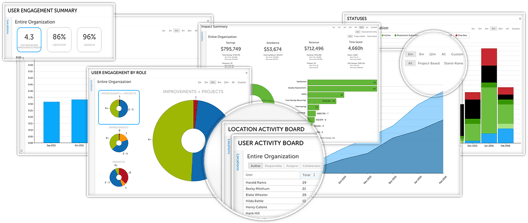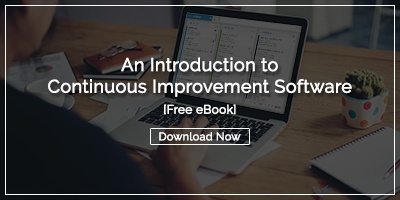 Deciding when to move from a paper system of managing continuous improvement to a digital system is tough. You know that you're not as effective or efficient as you could be, but growing pains in an improvement culture come on so gradually, it's hard to know how much better things could really get with the right platform.
Deciding when to move from a paper system of managing continuous improvement to a digital system is tough. You know that you're not as effective or efficient as you could be, but growing pains in an improvement culture come on so gradually, it's hard to know how much better things could really get with the right platform.
Let me tell you - things will get a lot better.
From breaking down silos to share improvement knowledge across the organization, capturing and reporting on impact metrics, and targeting coaching more effectively, continuous improvement software is a game changer in any improvement culture.
Here are three people who have made the leap. Listen as they explain what their improvement culture looked like before, and how things have changed for the better:
Expanding Visibility Beyond the Small Group
"Before we started with KaiNexus, we tried a couple of different tools. We had a wallboard for a small group of us, and we also expanded that to a spreadsheet. The small group thing kind of worked, but we failed in that we couldn’t share ideas outside of our area.
Moving to KaiNexus allowed us to compile all of our ideas and also share those, not just to our small group, but across the company. "
- Jake Snyder | Chair, LCI Austin Community of Practice
The guy in this video was Jake Snyder, but honestly, it could have been any one of our customers. This story - of starting with paper boards, deciding to get more organized in spreadsheets, and then realizing the shortcomings of a local system like this, is so common in Lean organizations.
You can read more about Snyder’s transition from paper to a digital system in this blog post he wrote a while back, but essentially, continuous improvement software takes the same information you have displayed on your wallboards and gets it onto a monitor displayed in the same place instead. Benefits of this are numerous, but arguably the most important result is that people anywhere in the organization are able to see the same boards, at the same time, from any screen. You can have one huddle board that updates in real time for teams across the organization, or a Kanban board that shows the work of all teams, rather than just the local one.
In this way, you can build a widespread improvement culture connected by technology, rather than get stuck with small improvement pockets scattered across the organization working independently.
Learn more about digital boards here:
Increasing Transparency into Processes & Outcomes
Before KaiNexus, we relied heavily on project report outs and PowerPoint slide decks where we listed out what happened in the project. Those went into a repository, but we couldn’t easily mine them to understand what was going on where.
KaiNexus gives us that searchable easy way to connect things, and go back and understand what didn’t work so we can go back and approach problems in a different way in the future.
- Chris Luckett | Network Manager - Process Excellence, Kettering Health Network
An institutional repository of improvement knowledge is perhaps the single most valuable resource you can build for your company. You see, it's not enough to make an improvement and move on - you need to share those improvements with others in the company in order to give each idea the maximum reach and impact, and you need to preserve those ideas going forward so that they serve as the basis for future progress.
By capturing improvements and outcomes in improvement software, people can look back at how the current standard was created and use that as the jumping-off point for future improvements. It's easy to see what impact certain improvements and projects have had, to improve your improvement process, and continuously grow as an organization in ways that you never will with a program based on spreadsheets.
For more information, check out this webinar:
Enabling More Effective Coaching
One of the big challenges we had with the paper improvement system we’d set up was that we, as Lean coaches, didn’t really know where managers were struggling throughout the organization, where staff may be struggling to come up with opportunities for improvement, or where things got lost on a desk and sat there. There was no way of assessing any of that.
With KaiNexus, I actually can get alerted if an improvement is sitting in a managers workplace and not being assigned for two weeks. I get notified, I can look at that. I can look at the reports to see if we have bottlenecks in that process and which managers to focus my coaching on.
- James Pryor, | Director of Lean Promotion Office, Summit Physician Services
Coaching an improvement culture is hard. You know that it's not enough to just train people once and release them into the wild to make improvements; they need interactive feedback, continuous coaching, and personalized guidance. You need to spot problems before they get out of hand and identify bottlenecks causing downstream problem. How do you do that though, when there are so many more employees than there are coaches?
Improvement software.
Think about it. You use technology to increase visibility and efficiency in pretty much every other aspect of your job, right? You don't leave letters in colleagues' mailboxes - you send an email. Why would managing improvement be any different?
Technology makes it possible to get a big picture view of the overall health of your improvement culture, as well as to drill down into specific locations, teams, and individuals to assess progress. You can set up an automated badging system to recognize people for engagement and improvements, and you can view the details of any project and offer coaching right there where the work is being done. You can view the Kanban and Huddle Boards from across the organization from your desk so that you can decide where to allocate your valuable time on-site, and you can pull automatically-generated reports that show you where bottlenecks are forming so you can jump in and coach for improvement.
Coaches that use KaiNexus to increase their efficiency are able to make smarter choices about where to spend time and resources, thus driving a more effective change initiative.
For more information about how improvement software and why it's been a game-changer for organizations around the world, check out this free eBook:





Add a Comment